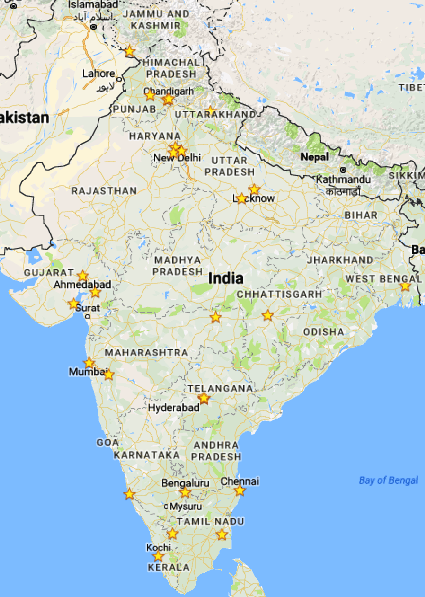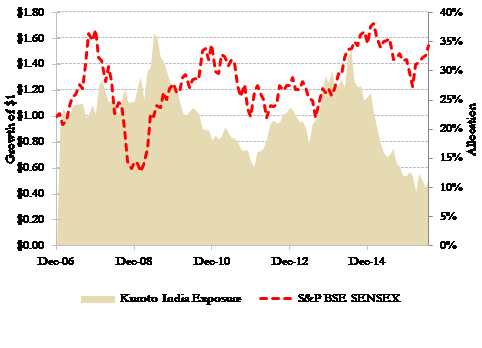Kuroto Fund, L.P. - Q2 2016 Letter
Dear Partners and Friends,
PERFORMANCE & PORTFOLIO
In the second quarter of 2016, Kuroto increased +2.4% while the MSCI Emerging Markets Index rose +0.8%. As of September 14, Kuroto was up +14.5% for the year to date and the MSCI EM Index increased by +13.9%.[1]
During the quarter, the number of companies held in the portfolio declined to 26. We sold a consumer staples producer in Indonesia and a manufacturer in India, while we purchased an Indian financial.
Our Investment History in India
When we made our first investment in India at the end of the last century, local financial markets were incredibly immature. Just getting annual reports for companies often involved either going to visit a company or contacting a company by mail and asking them to mail back a report. Indian shares had only recently been dematerialized, and the risk of buying fake shares was still a common topic of discussion. Moreover, the Indian economy was thought to lack the ingredients that made South East Asian economies so dynamic: 4% was the limit to the Hindu rate of growth, or so it was thought. This backdrop of pessimism was, of course, a stock picker’s dream. We found great prospective investments by simply running a screen of all companies sorted by ROE.
Even as the market took off in the 2004-2006 period, the opportunities in India were still robust. For instance, we were able to own shares in Dabur in 2004 at a high single-digits multiple to earnings. At the time, Dabur had a very profitable portfolio of branded products from shampoo to snack foods and was run by a former Pepsi Co. executive. In short, Dabur was a mini Hindustan Unilever, but with higher growth and trading at a lower multiple than Unilever’s 14x trailing earnings.
To put those opportunities into context, Dabur now trades for 36x earnings and Hindustan Unilever trades for more than 40x earnings. While still great companies, the valuation of these and similar companies in India have been prohibitive for value investors, such as ourselves, for years. As market multiples rose, we ventured beyond the commonly visited cities of Mumbai, Delhi, and Bangalore and in turn found new, compelling companies.
India: where we’ve been
The process of traveling to second and third tier Indian cities didn’t just generate good investments; it also helped us gain an appreciation for India’s diversity. To say “India is this” or “India is that” is indeed a wild simplification. As Gurcharan Das observed at the beginning of India Unbound, the most remarkable thing about Indian history is that it remained one country. Beyond India’s linguistic, cultural, and ethnic diversity, with more than 5,000 listed companies, India is also home to an amazing breadth of corporates. In fact, India has the most domestically listed companies in the world.[2]
This diversity of companies coupled with the volatility in the Indian stock market has continued to yield opportunities in recent years. Since 2010, Indian stocks have declined by more than 20% in U.S. dollars on four separate occasions (graph below). In 2011, for example, when other markets were doing well, the Sensex declined 36% in dollars. This created a unique opportunity to invest in great businesses in India, when similar quality businesses were far more expensive in other emerging markets. And again, in 2013, the Indian market and currency declined, and we were able to take full advantage.
In both of those cases, macroeconomic and political concerns led many investors to ignore the underlying fundamentals of specific companies. Our history with these companies and the comfort with the earnings power and durability of their franchises gave us the conviction to adhere to our value discipline.
It is important to emphasize that as good as those opportunities were in early 2012 and the summer of 2013, they don’t exist today. Narendra Modi’s government is unfortunately living proof of the idea that anticipation is greater than realization, with much of the Indian stock market still discounting the expectations. That is, the hoped-for pickup in private investment and economic activity is still just that, a hope.
The markets are also still holding out hope on a range of politically-difficult economic reforms: land, legal, tax, political, and bureaucratic reforms. But, even if none of these reforms materialize, the infrastructure improvements under the Modi administration may themselves be sufficient to justify much of the market’s optimism. Our travels over the years have impressed upon us India’s desperate need for better infrastructure. Under this government, India has experienced a massive construction of roads and railways on a scale unprecedented in the country’s history. In our opinion, this policy alone could have a long-term benefit that should not be underestimated.
Given valuations at this point, we see the balance of risk higher than the likely reward of investing in most Indian companies. Accordingly, we have reduced our allocation to India to the low double digits. The benefit of having a global fund is that we are able to shift money from one country or region to another as the opportunity set changes. Our understanding of the companies, the politics, and the country more generally will tell us when valuations are giving us the opportunity to increase Kuroto’s exposure to Indian companies. In the meantime, we will patiently adhere to our discipline and only own the rare instance of a better business trading at a discount to its intrinsic value.
Sincerely,
Sean Fieler
Daniel Gittes
ENDNOTES
[1] Performance stated for Kuroto Fund, L.P. Class A on a net basis. An investor’s performance may differ based on timing of contributions, withdrawals, share class, and participation in new issues. Performance contribution as stated uses the fund’s dollar-weighted gross internal rate-of-return calculations derived from average capital and sector P&L. Sector performance figures are derived using monthly performance contribution calculations in US dollars, gross of all fees and fund expenses. P&L and exposures on cash and currency forwards included under Cash.
[2] World Bank












